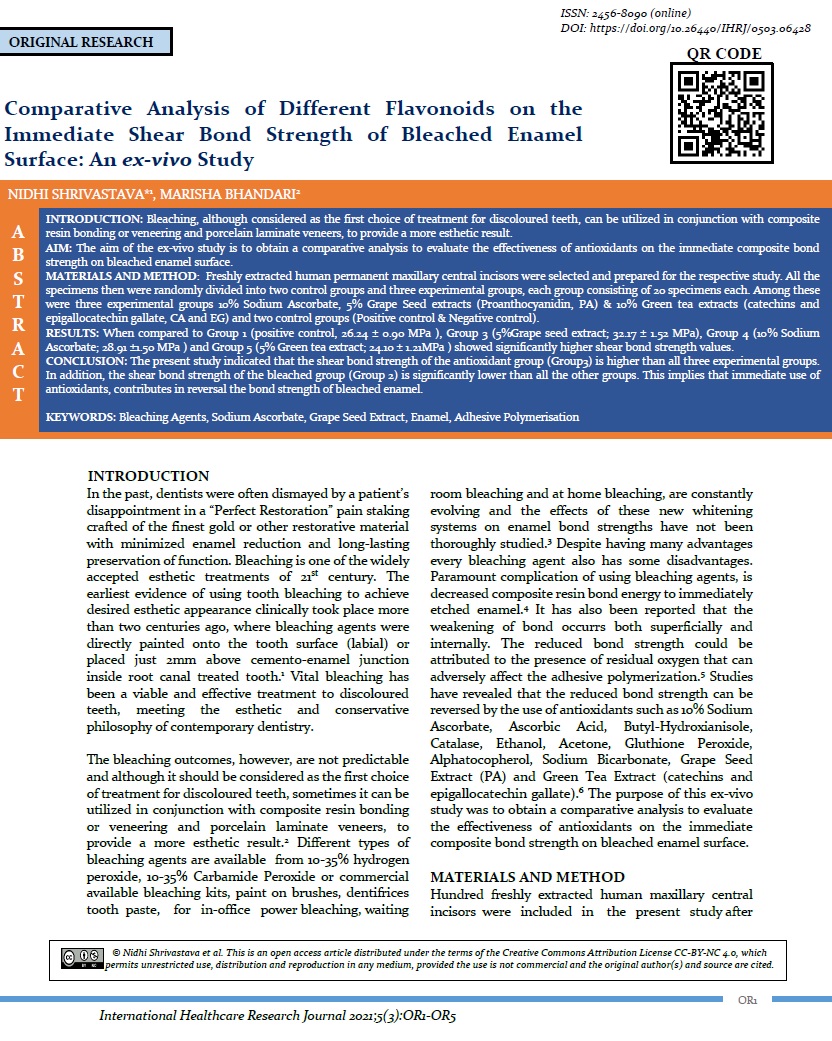Comparative Analysis of Different Flavonoids on the Immediate Shear Bond Strength of Bleached Enamel Surface: An ex-vivo Study
Abstract
INTRODUCTION: Bleaching, although considered as the first choice of treatment for discoloured teeth, can be utilized in conjunction with composite resin bonding or veneering and porcelain laminate veneers, to provide a more esthetic result.
AIM: The aim of the ex-vivo study is to obtain a comparative analysis to evaluate the effectiveness of antioxidants on the immediate composite bond strength on bleached enamel surface.
MATERIALS AND METHOD: Freshly extracted human permanent maxillary central incisors were selected and prepared for the respective study. All the specimens then were randomly divided into two control groups and three experimental groups, each group consisting of 20 specimens each. Among these were three experimental groups 10% Sodium Ascorbate, 5% Grape Seed extracts (Proanthocyanidin, PA) & 10% Green tea extracts (catechins and epigallocatechin gallate, CA and EG) and two control groups (Positive control & Negative control).
RESULTS: When compared to Group 1 (positive control, 26.24 ± 0.90 MPa ), Group 3 (5%Grape seed extract; 32.17 ± 1.52 MPa), Group 4 (10% Sodium Ascorbate; 28.91 ±1.50 MPa ) and Group 5 (5% Green tea extract; 24.10 ± 1.21MPa ) showed significantly higher shear bond strength values.
CONCLUSION: The present study indicated that the shear bond strength of the antioxidant group (Group3) is higher than all three experimental groups. In addition, the shear bond strength of the bleached group (Group 2) is significantly lower than all the other groups. This implies that immediate use of antioxidants, contributes in reversal the bond strength of bleached enamel.
Downloads
References
Manoharan M, Shashibhushan KK, Poornima P, Nik SN, Patil D, Shruthi AS. Effect of newer antioxidants on the bond strength of composite on bleached enamel. J Indian Soc Pedod Prev Dent. 2016;34:391-6. https://doi.org/10.4103/0970-4388.191430
Heymann HO. Additional conservative esthetic procedures. In: Roberson TM, Haymann HO, Swifth EJ. Sturdevent’s Art and Science of Operative dentistry. 5th ed. Noida: Reed Elsevier India Private Limited;2009. P. 625-41.
Dabas D, Patil AC, Uppin VM. Evaluation of the effect of concentration and duration of application of sodium ascorbate hydrogel on the bond strength of composite resin to bleached enamel. J Conserv Dent. 2011;14:356-60.
Basting RT, Rodrigues JA, Serra MC, Pimenta LA. Shear bond strength of enamel treated with seven carbamide peroxide bleaching agents. J Esthet Restor Dent. 2004;16:250-9.
Oskoee PA, Navimipour EJ, Oskoee SS, Moosavi N. Effect of 10% sodium ascorbate on bleached bovine enamel surface morphology and microhardness. Open Dent J. 2010;4:207-10. https://doi.org/10.2174/1874210601004010207
Garcia EJ, Oldoni TL, Alencar SM, Reis A, Loguercio AD, Grande RH. Antioxidant activity by DPPH assay of potential solutions to be applied on the bleached teeth. Braz Dent J. 2012;23:22-7. https://doi.org/10.1590/s0103-64402012000100004
Crim GA. Post-operative bleaching: effect on microleakage. Am J Dent 1992;5:109-12.
Cvitko E, Denehy GE, Swift EJ Jr., Ambrose WW, Lopes M. ultra-morphological study of interaction of dental adhesives with carbamide peroxide-bleached enamel.AM J Dent. 1998;11:291-301.
Titley KC, Torneck CD, Smith DC, Adibfar A. Adhesion of composite resin to bleached and unbleached bovine enamel. J Dent Res. 1998;67:1523-8.
Stokes AN, Hood JA, Dhariwal D, Patel K. effect of peroxide bleaches on resin enamel bonds. Quintessence Int. 1992;23:769-71.
Miles PG, Pontier JP, Bahiraei D, Close J. the effect of carbamide peroxide bleach on the tensile bond strength of ceramic brackets: an in vitro study. Am J Orthod Dentofacial Orthop. 1994;106:371-5. https://doi.org/10.1016/S0889-5406(94)70058-3
Torres CRG, Koga AF, Borges AB. The effects of anti-oxidant agents as neutralizers of bleaching agents on enamel bond strength. Braz Dent J. 2006;5:971-76. https://doi.org/10.20396/bjos.v5i16.8641877
Kimyai S, Oskoee SS, Rafighi A, Valizadeh H, Ajami AA, Helali ZN. Comparision of the effect of hydrogel and solution forms of sodium ascorbate on orthodontic bracket-enamel shear bond strength immediately after bleaching: an in vitro study. Indian J Dent Res. 2010;21:54-8.
Berger SB, De Souza Carreira RP, Guiraldo RD, Lopes MB, Pavan S, Giannini M, et al. Can green tea be used to reverse compromised bond strength after bleaching? Eur J Oral Sci. 2013;121(4):377–81. https://doi.org/10.1111/eos.12062
Magalhaes AC, Wiegand A, Rios D, Hannas A, Attin T, Buzalaf MA. Chlorhexidine and green tea extract reduce dentin erosion and abrasion in situ. J Dent. 2009;37:994-8. 10.1016/j.jdent.2009.08.007
Spyrides GM, Perdigao J, Pagani C, Araujo MA, Spyrides SM. Effect of whitening agents on dentin bonding. J Esthet Dent. 2000;12:264-70.
Hattab FN, Qudeimat MA, al-Rimawi HS. Dental discoloration: an overview. J Esthet Dent. 1999;11:291-310.
Carr AC, Tijerina T, Frei B. Vitamin C protects against and reverses specific hypochlorous acid and chloramine-dependent modifications of low density lipoprotein. Biochem J. 2000;346(pt 2):491-9.

Copyright (c) 2021 Nidhi Shrivastava et al.

This work is licensed under a Creative Commons Attribution-NonCommercial 4.0 International License.


